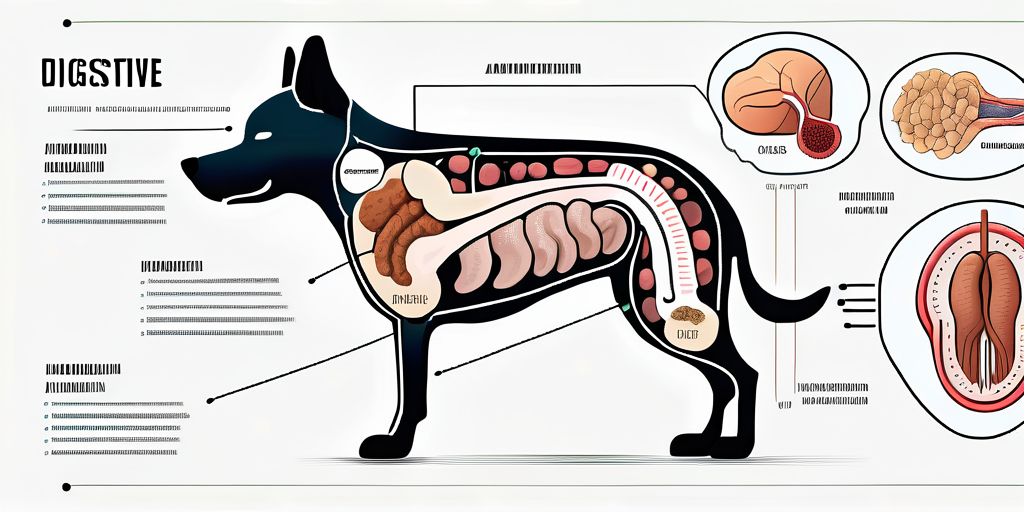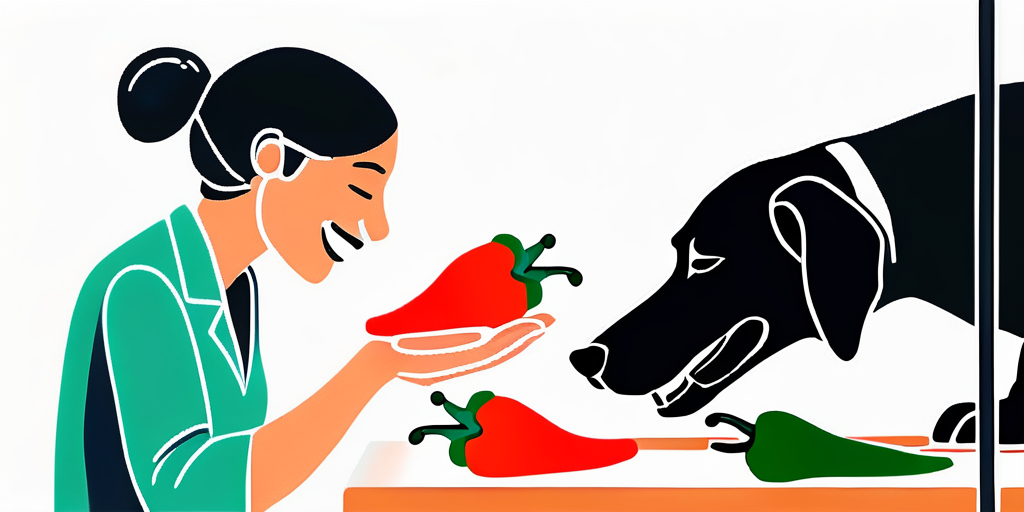Many pet owners wonder whether it’s safe to feed peppers to their dogs. Peppers are a popular vegetable known for their vibrant colors and distinct flavors. While peppers can be a healthy addition to a human’s diet, it’s important to consider whether they are suitable for dogs. In this article, we will explore the topic of dogs and peppers in detail, discussing their impact on canine health and potential risks. We will also provide guidelines on how to safely introduce peppers into your dog’s diet.
Understanding a Dog’s Digestive System
A dog’s digestive system is different from that of humans. Dogs have shorter and more acidic digestive tracts, which allows them to process certain foods more efficiently. However, their digestive system may not be able to handle certain foods that are safe for humans.

The Basics of Canine Nutrition
Before we dive into the specific details about peppers, it’s essential to understand the basics of canine nutrition. Dogs need a balanced diet that includes proteins, carbohydrates, fats, vitamins, and minerals. These nutrients are necessary for maintaining their overall health and well-being.
Proteins are the building blocks of a dog’s body, helping to repair and build tissues. Carbohydrates provide energy, while fats are vital for hormone production and nutrient absorption. In addition, vitamins and minerals play a crucial role in supporting various bodily functions.
When it comes to proteins, dogs have specific dietary requirements. They need high-quality animal-based proteins, such as those found in meat, fish, and poultry. These proteins contain essential amino acids that dogs cannot produce on their own. It’s important to ensure that your dog’s diet includes a sufficient amount of these proteins to meet their nutritional needs.
Carbohydrates, on the other hand, should be provided in moderation. While dogs can digest and utilize carbohydrates, they have a limited ability to break down complex carbohydrates. Simple carbohydrates, such as those found in fruits and vegetables, are easier for dogs to digest and can provide them with beneficial nutrients.
Fats are another essential component of a dog’s diet. They are a concentrated source of energy and help with the absorption of fat-soluble vitamins. However, it’s important to choose healthy sources of fats, such as those found in fish or plant-based oils, and avoid excessive amounts that can lead to weight gain and other health issues.
How Dogs Process Different Foods
When it comes to processing different foods, dogs have certain limitations. While they can safely consume some human foods, others can be harmful to their health. It’s important to be aware of these limitations to ensure that you’re providing your dog with a safe and appropriate diet.
One crucial factor to consider is a dog’s ability to digest and break down certain substances. For example, dogs lack the necessary enzymes to efficiently digest plants such as peppers. This makes it challenging for them to extract the maximum nutritional benefit from these foods.
Additionally, dogs have a more acidic stomach environment compared to humans. This acidity helps them break down and kill harmful bacteria that may be present in their food. However, it also means that they may have difficulty digesting certain foods that require a more alkaline environment for proper breakdown.
Furthermore, dogs have a shorter digestive tract compared to humans. This means that food passes through their system more quickly, allowing for less time for nutrient absorption. As a result, it’s important to provide dogs with a diet that is highly digestible and nutrient-dense to ensure they receive the necessary nutrients in a shorter amount of time.
The Different Types of Peppers
Peppers come in various shapes, sizes, and heat levels. The most commonly consumed peppers include bell peppers and hot peppers. Both types have their own nutritional compositions and effects on a dog’s digestive system.
Bell Peppers and Their Nutritional Value
Bell peppers are known for their mild taste and bright colors. These peppers are rich in vitamins A and C, providing essential antioxidants that promote immune function and overall health. They are also a good source of fiber, which aids digestion.
Feeding bell peppers to your dog in moderation can be a healthy addition to their diet. However, it’s important to remove the seeds and stems before serving, as they can be difficult for dogs to digest and may pose a choking hazard.
The Impact of Hot Peppers on Dogs
In contrast to bell peppers, hot peppers contain a compound called capsaicin, which gives them their spicy taste. Capsaicin can cause irritation and discomfort in a dog’s digestive system, leading to digestive upset or even gastrointestinal inflammation.
It’s best to avoid feeding hot peppers to your dog altogether, as their spicy nature can cause more harm than good. If your dog accidentally consumes hot peppers, monitor them closely for any signs of discomfort or distress.
Now, let’s delve deeper into the world of peppers and explore some lesser-known varieties. One such variety is the poblano pepper, which is popular in Mexican cuisine. Poblano peppers have a mild to medium heat level and are often used in dishes like chiles rellenos, where they are stuffed with cheese or meat and then battered and fried.
Another interesting type of pepper is the habanero pepper, known for its intense heat. Native to the Caribbean, habanero peppers are one of the hottest peppers in the world. They are often used sparingly in recipes to add a fiery kick, but caution should be exercised when handling and consuming them.
Aside from their heat levels, peppers also come in a variety of colors. For example, there are red, green, yellow, and even purple peppers. The color of a pepper is determined by its stage of ripeness, with green peppers being the least ripe and red peppers being fully mature.
When it comes to cooking with peppers, the possibilities are endless. They can be sautéed, roasted, stuffed, or even pickled. Peppers can add flavor, color, and a hint of spice to a wide range of dishes, from salads and stir-fries to soups and stews.
So, the next time you’re at the grocery store, take a moment to appreciate the diverse world of peppers. Whether you’re a fan of the mild and sweet bell peppers or you prefer the fiery heat of hot peppers, there’s a pepper out there to suit every taste bud.
Potential Health Benefits of Peppers for Dogs
While not all peppers are suitable for dogs, some types do offer certain health benefits when fed in moderation. Let’s explore the potential advantages of incorporating peppers into your dog’s diet.

Vitamins and Minerals in Peppers
Bell peppers, in particular, are packed with essential vitamins and minerals that can support your dog’s overall health. Vitamin A promotes healthy vision and immune function, while vitamin C boosts the production of collagen and acts as an antioxidant.
In addition, peppers are a good source of minerals such as potassium, which helps maintain healthy heart function, and magnesium, which supports muscle and nerve function.
Antioxidants in Peppers and Their Role
Peppers, especially brightly colored ones, are rich in antioxidants. Antioxidants help neutralize harmful free radicals in the body, reducing the risk of chronic diseases and supporting overall cellular health.
Introducing peppers to your dog’s diet in moderation can provide them with an extra boost of antioxidants, which may promote their longevity and well-being.
Risks and Side Effects of Feeding Peppers to Dogs
While peppers can offer certain health benefits, it’s important to be aware of the potential risks and side effects associated with feeding them to dogs.

Possible Digestive Issues
As mentioned earlier, dogs have a more sensitive digestive system than humans. Feeding them peppers, even in small amounts, can cause digestive issues such as diarrhea, gas, or upset stomach. Some dogs may be more sensitive to these effects than others.
If you notice any signs of digestive discomfort after feeding your dog peppers, it’s best to discontinue their consumption immediately and consult with a veterinarian.
Allergic Reactions to Peppers in Dogs
Just like humans, dogs can develop allergies to certain foods, including peppers. Symptoms of an allergic reaction in dogs may include itching, redness, swelling, or even difficulty breathing.
If you suspect that your dog has developed an allergic reaction to peppers, it’s crucial to seek veterinary assistance right away. They can help diagnose the allergy and provide guidance on the best course of action.
Safe Ways to Introduce Peppers to Your Dog’s Diet
If you decide to incorporate peppers into your dog’s diet, it’s essential to do so in a safe and gradual manner. Follow these guidelines to ensure a smooth transition:
Preparing Peppers for Your Dog
When preparing peppers for your dog, it’s important to remove the seeds, stems, and core. These parts can be tough for dogs to digest and may pose a choking hazard.
Slice the peppers into small, manageable pieces that your dog can comfortably chew. It’s recommended to cook the peppers before feeding them to your dog, as this can help break down the vegetable and make it easier to digest.
Determining the Right Serving Size
The appropriate serving size of peppers for your dog will depend on their size, age, and overall health. Start with small amounts and gradually increase the portion size over time.
Monitor your dog closely for any signs of digestive issues or allergies after introducing peppers to their diet. If they tolerate peppers well, you can continue to offer them occasionally as a healthy treat or addition to their meals.
In conclusion, while peppers can offer certain health benefits for dogs, it’s important to exercise caution and moderation. Consider your dog’s digestive system, their individual tolerance, and consult with a veterinarian if you have any concerns. By following these guidelines, you can safely include peppers in your dog’s diet and provide them with a nutritious and enjoyable culinary experience.
